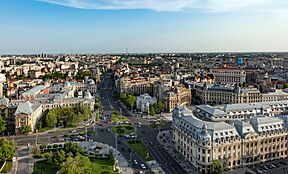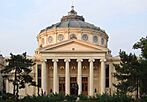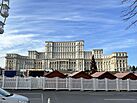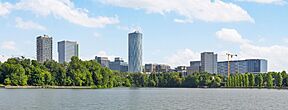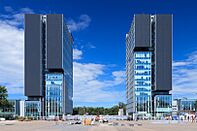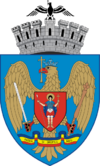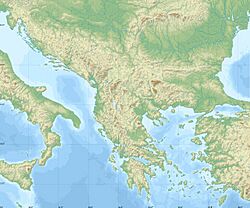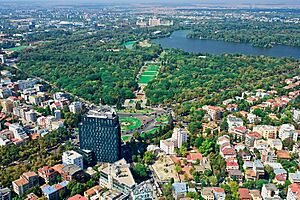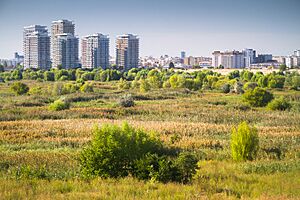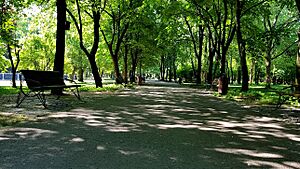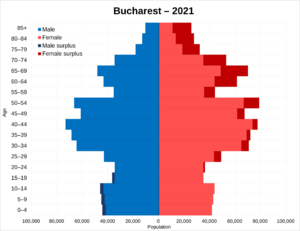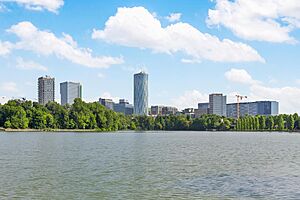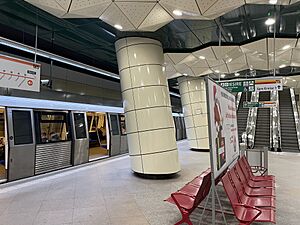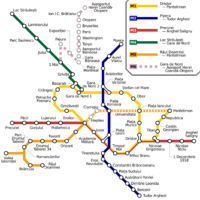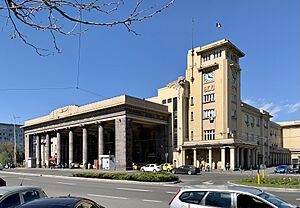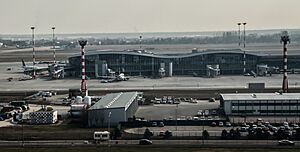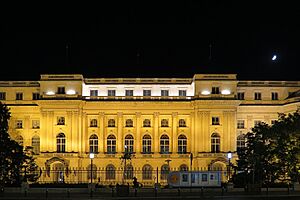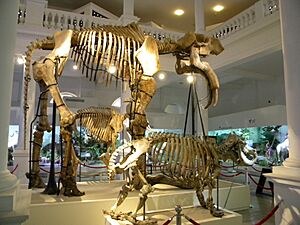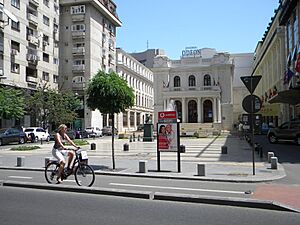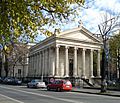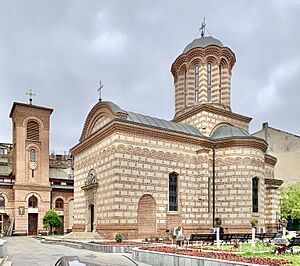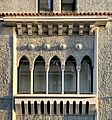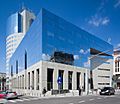Bucharest facts for kids
Quick facts for kids
Bucharest
București
|
|||||
|---|---|---|---|---|---|
| City of Bucharest | |||||
|
University Square
Romanian Athenaeum
Palace of Parliament
Central University Library
Palace of Justice
Floreasca
CEC Palace
King Michael I Park
Bucharest Old Town
City Gate Towers
|
|||||
|
|||||
| Nicknames:
Paris of the East / Little Paris
|
|||||
| Motto(s):
Patria și dreptul meu
(The Homeland and my right) |
|||||

Bucharest highlighted red in Romania
|
|||||
| Country | |||||
| Development region | București – Ilfov | ||||
| County | Municipality of Bucharest | ||||
| First attested | 1459 | ||||
| Founded by | Vlad the Impaler | ||||
| Sectors | 6 sectors | ||||
| Government | |||||
| • Type | Strong Mayor–Council | ||||
| Area | |||||
| • Capital city and municipality | 239 km2 (92.28 sq mi) | ||||
| • Metro | 1,803 km2 (696 sq mi) | ||||
| Elevation | 55.8–91.5 m (183.1–300.2 ft) | ||||
| Population
(2021 census)
|
|||||
| • Capital city and municipality | 1,716,961 | ||||
| • Estimate
(January 2024)
|
1,719,958 | ||||
| • Rank | 1st in Romania (8th in the EU) | ||||
| • Density | 7,196/km2 (18,640/sq mi) | ||||
| • Metro | 2,303,505 (Bucharest-Ilfov) | ||||
| • Metro density | 1,277/km2 (3,310/sq mi) | ||||
| Demonyms | Bucharester (en) bucureștean, bucureșteancă (ro) |
||||
| GDP (2024) | |||||
| • Capital city and municipality | € 88.18 billion (25.4% of Romania) | ||||
| • Metro | € 97.74 billion (28.2% of Romania) | ||||
| • Per capita (City) | € 50,751 | ||||
| Time zone | UTC+02:00 (EET) | ||||
| • Summer (DST) | UTC+03:00 (EEST) | ||||
| Postal code |
0100xx-0201xx, 0201xx-0300xx, 0365xx
|
||||
| Area code(s) | +40 31 | ||||
| HDI (2024) | 0.926 – very high | ||||
| Rapid transit system | Metro | ||||
| International Airports |
|
||||
Bucharest (pronounced BOO-kə-REST) is the capital and largest city of Romania. It's located in the southeastern part of the country, on the Dâmbovița River. About 1.7 million people live in the city, and over 2.3 million live in the wider metropolitan area. This makes Bucharest one of the largest cities in the European Union.
The city was first mentioned in official papers in 1459. It became Romania's capital in 1862. Bucharest is a major center for media, culture, and business in Romania. Its buildings show a mix of old styles, like Neoclassical and Art Nouveau, and newer ones.
Between the two World Wars, Bucharest was known for its beautiful buildings and fancy lifestyle. People even called it "Little Paris" or the "Paris of the East." Even though some parts of the city were damaged by wars and earthquakes, many old buildings have been fixed up. Today, Bucharest is growing fast, especially in technology. It's one of the quickest-growing tech cities in Europe.
Bucharest is the richest city in Romania. It has many places for meetings, schools, cultural events, shops, and fun areas. The city is divided into six parts, called sectors, each with its own local leader.
Contents
What's in a Name?
The Romanian name for the city is București. No one is completely sure where the name came from. Some old stories say it was named after a prince, a fisherman, or a shepherd named Bucur.
In Romanian, the word bucurie means 'joy' or 'happiness'. So, Bucharest could mean 'city of joy'. An old traveler from the Ottoman Empire once said it was named after someone called 'Abu-Kariș'.
People from Bucharest are called 'Bucharesters'.
Bucharest's Story
Bucharest has a long and interesting history. It has seen times of great growth and times of difficulty. The city was first mentioned in 1459 as the 'Citadel of București'. It became the home of the ruler of Wallachia, Vlad the Impaler.
The Curtea Veche (Old Princely Court) was built in the mid-1500s. Bucharest later became the main home for the royal court after 1698. Over the next 200 years, the city was damaged by natural disasters and rebuilt many times.
In the 1800s, Bucharest was affected by a serious illness called Caragea's plague. The city was also taken over several times by different empires, like the Habsburg monarchy and Imperial Russia. In 1847, a big fire destroyed about a third of the city.
Becoming the Capital
In 1862, two regions, Wallachia and Moldavia, joined to form the Principality of Romania. Bucharest then became the capital of this new country. In 1881, it became the political center of the new Kingdom of Romania.
During the late 1800s, Bucharest grew a lot. New things like gas lighting and horse-drawn trams were introduced. The Dâmbovița River was also changed to stop floods. The city's beautiful buildings and lively culture earned it the nickname 'Paris of the East'.
Between 1916 and 1918, during World War I, German forces took over the city. The capital was temporarily moved to another city called Iași. After World War I, Bucharest became the capital of a larger Romania. The city continued to grow, with many new people moving in each year. Some famous landmarks, like the Arcul de Triumf, were built then.
Modern Times
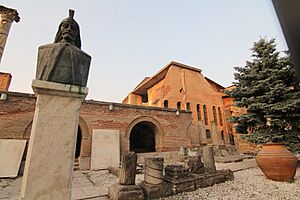
During World War II, Bucharest was bombed by Allied forces. This was because it was a major stop for Axis troops. In August 1944, Romania switched sides and joined the Allies. The city then faced some bombings from German planes.
After the war, communism came to Romania. Bucharest kept growing, and many new apartment buildings were constructed. Under the leader Nicolae Ceaușescu, parts of the historic city were torn down. They were replaced with huge buildings, like the Palace of the Parliament.
In 1977, a big earthquake caused a lot of damage and took many lives. The Romanian Revolution of 1989 started with protests in other cities and then in Bucharest. This led to the end of the Communist government.
Since the year 2000, Bucharest has been modernized a lot. New homes and businesses have been built, especially in the northern parts of the city. The old historic center has also been restored.
Important Agreements
Several important agreements, called treaties, were signed in Bucharest:
- Treaty of Bucharest (1812): Ended a war between the Ottoman Empire and Russia.
- Treaty of Bucharest (1886): Ended a war between Serbia and Bulgaria.
- Treaty of Bucharest (1913): Ended the Second Balkan War.
- Treaty of Bucharest (1916): An agreement for Romania to join the Allies in World War I.
- Treaty of Bucharest (1918): An agreement between Romania and the Central Powers.
Where is Bucharest?
Bucharest is located on the Dâmbovița River. This river eventually flows into the Danube River. There are several lakes in the northern part of the city, like Lake Herăstrău and Lake Floreasca. In the city center, there's a small artificial lake called Lake Cișmigiu. It's surrounded by the beautiful Cișmigiu Gardens, which opened in 1847.
Parks and Green Spaces
Bucharest has many parks and gardens. Some of the most famous are Herăstrău Park, Tineretului Park, and the Botanical Garden. Herăstrău Park is in the north and includes the Village Museum. Tineretului Park was made in 1965 and has a special play area for kids called Mini Town. The Botanical Garden is the largest in Romania, with over 10,000 types of plants.
Lake Văcărești is in the southern part of the city. It's a unique natural area with many birds and animals. It was once a village that was supposed to become a lake, but the plan was stopped. Nature took over, and in 2016, it became a national park, known as the 'Delta of Bucharest'.
Bucharest is built on a flat area that was once a large forest. Like Rome, it is traditionally said to be built on seven hills. These include Mihai Vodă, Dealul Mitropoliei, and Cotroceni.
The city covers an area of about 226 square kilometers. Its height above sea level changes from about 55 meters to 91 meters. The city is roughly round, with the center at University Square. The distance from the center to the edge of the city is about 10 to 12 kilometers in all directions.
The areas around Bucharest used to be mostly farms. But since 1989, new towns have grown up around the city. These are like suburbs where many people live and then travel to Bucharest for work.
Weather in Bucharest
Bucharest has a climate with hot, humid summers and cold, snowy winters. Because it's on a flat plain, winters can be windy. Temperatures often drop below freezing in winter, sometimes even to -10°C. In summer, the average high temperature is around 30°C in July and August. It can often reach 35°C to 40°C in the middle of summer.
Even though there's moderate rain in summer, sometimes there are heavy storms. In spring and autumn, daytime temperatures are usually between 17°C and 22°C. Spring tends to have more rain than summer, but the rain is usually lighter.
How Many People Live Here?
According to the 2021 census, 1,716,961 people live in Bucharest. This number is a bit lower than in 2011. This is partly because some people have moved to smaller towns around the city. Bucharest is the eighth largest city in the European Union by population within its city limits.
Bucharest is a very crowded city, with many people living in apartment buildings. Most of these buildings were built during the communist era. About 97% of the people in Bucharest are Romanian. Other groups include Romani, Hungarians, Turks, Jews, and Germans.
Most people in Bucharest (96.1%) are Romanian Orthodox Christians. A smaller number are Roman Catholic or Muslim. Even though many people have a religion, only about 18% go to a place of worship every week. People in Bucharest tend to live longer than the national average.
Bucharest's Economy
Bucharest is the heart of Romania's economy and industry. It produces about a quarter of the country's total wealth. About one-third of all national taxes are paid by people and companies in Bucharest. The living standard in Bucharest is much higher than the average for Romania.
After a slow period in the 1990s, the city's economy has grown strongly. This has led to new shopping malls, homes, and office buildings. Bucharest is also Romania's biggest center for information technology. Many large Romanian companies have their main offices here. The Bucharest Stock Exchange is also very important to the city's economy.
Many large shopping centers have been built since the late 1990s, like Băneasa Shopping City and AFI Palace Cotroceni. Bucharest has more than 20 malls. Big companies like Amazon, Microsoft, Ubisoft, Oracle Corporation, and IBM have offices in Bucharest. The city also has very fast internet speeds.
-
IBM Bucharest office.
-
Floreasca City Center with SkyTower and Oracle headquarters.
-
Amazon has offices in the Globalworth Tower.
-
Petrom City.
Getting Around Bucharest
Bucharest is connected by two major international transport routes.
Public Transport
Bucharest has the largest public transport system in Romania. It includes the Bucharest Metro, which is a subway system, and a surface transport system. The surface system has buses, trams, and trolleybuses. There are also private minibuses and many taxis.
The Bucharest Metro has five lines and is a fast way to travel. The first metro line opened in 1979, and the newest one opened in 2020. A sixth line is being built.
Trains
Bucharest is the main hub for Romania's national railway network. The main train station is Gara de Nord (North Station). From here, you can travel to all major cities in Romania and to other countries like Hungary, Bulgaria, and Ukraine.
The city has five other train stations. The oldest station, Filaret, opened in 1869 but is now a bus terminal.
Airports
Bucharest has two airports:
- Henri Coandă International Airport (OTP): This is Romania's busiest airport, located about 16.5 km north of the city center.
- Aurel Vlaicu International Airport (BBU): This airport is for business and VIP flights and is closer to the city center, about 8 km north.
Roads
Bucharest is a major point in Romania's road network. Important national roads and highways connect the city to other major cities and neighboring countries. The A1, A2, and A3 motorways all start from Bucharest.
The city has many large boulevards that spread out from the center. These roads handle most of the traffic. Roads can get very crowded during busy hours because many people own cars now. In 2013, over 1.1 million cars were registered in Bucharest.
In 2011, the Basarab Overpass was opened. This huge bridge helped to improve traffic flow in the city. It is the longest cable-stayed bridge in Romania.
-
Mercedes-Benz Citaro bus.
Waterways

Even though Bucharest is on a river, it has never been a major port city. Other Romanian cities handle most of the country's shipping. There is an unfinished canal, the Danube-Bucharest Canal, which could connect Bucharest to the Danube River and the Black Sea. Work on this canal stopped in 1989.
Bucharest's Culture
Bucharest has a lively cultural scene, with lots of visual arts, performing arts, and nightlife. Its culture is a mix of Romanian and international styles.
Famous Landmarks
Bucharest has many famous buildings and monuments. The most well-known is the Palace of the Parliament. It was built in the 1980s under the communist leader Nicolae Ceaușescu. It is one of the largest Parliament buildings in the world. It houses the Romanian Parliament and the National Museum of Contemporary Art.
Another famous landmark is the Arcul de Triumf ("The Triumphal Arch"). It was built in 1935 and looks like the Arc de Triomphe in Paris. A newer landmark is the Memorial of Rebirth, built in 2005. It remembers the people who died in the Romanian Revolution of 1989.
The Romanian Athenaeum is a symbol of Romanian culture. It was built between 1886 and 1888 with public money. The InterContinental Bucharest hotel is also a city landmark, known for its unique views from every room.
The House of the Free Press (Casa Scânteii) looks like the Lomonosov Moscow State University. It was built in the 1950s to be a center for all official newspapers and publishers. It's the only building in Bucharest with communist symbols carved into its walls.
Other cultural places include the National Museum of Art of Romania, Grigore Antipa National Museum of Natural History, and the Museum of the Romanian Peasant.
Art and Museums
Bucharest has museums with both old and new Romanian art, as well as art from other countries. The National Museum of Art of Romania is very famous. It's in the royal palace and has art from the Middle Ages and modern times. It includes works by the famous sculptor Constantin Brâncuși.
Smaller museums have special collections. The Zambaccian Museum has works by well-known Romanian artists and international artists like Paul Cézanne and Pablo Picasso. The Theodor Pallady Museum is in one of the oldest merchant houses and shows works by painter Theodor Pallady.
The National Museum of Contemporary Art (MNAC) opened in 2004. It shows modern art from Romania and other countries. Private art galleries are also found around the city center.
The National Bank of Romania building has the national collection of money. It shows banknotes, coins, and other items related to money.
Shows and Performances
Performing arts are a big part of Bucharest's culture. The Romanian Athenaeum hosts classical music concerts and is home to the George Enescu Philharmonic Orchestra.
Bucharest is home to the Romanian National Opera and the I.L. Caragiale National Theatre. There's also the State Jewish Theatre, which features the famous actress Maia Morgenstern. Many smaller theaters offer different types of shows.
Music and Nightlife
Bucharest is where many Romanian musicians live and where the biggest music labels are. Old rock bands like Iris are still popular. Since the 1990s, the hip-hop scene has grown, with bands like B.U.G. Mafia known both in Romania and internationally.
The city has a good jazz and blues scene, as well as house music and heavy metal. There isn't one main area for nightlife. Instead, fun places are spread out, with many in the Lipscani area and Regie.
Cultural Events
Many cultural festivals happen in Bucharest throughout the year, especially in summer. The National Opera holds an International Opera Festival every May and June. The George Enescu Festival takes place every two years in September.
The Museum of the Romanian Peasant and the Village Museum host events that show Romanian folk arts. In recent years, Chinese cultural events have also become popular due to the growing Chinese community.
In 2005, Bucharest was the first city in Southeastern Europe to host the international CowParade. This event placed many decorated cow sculptures around the city. Since 2005, Bucharest also has its own modern art show called the Bucharest Biennale.
Traditional Culture
Traditional Romanian culture is very important in Bucharest's arts. The city has two famous museums about Romanian culture: the Museum of the Romanian Peasant and the open-air Dimitrie Gusti National Village Museum. The Village Museum has 272 real buildings and farms from all over Romania.
The Museum of the Romanian Peasant was named the European Museum of the Year in 1996. It has a huge collection of peasant items, including pottery, clothes, and wooden objects.
The Museum of Romanian History shows Romanian history and culture from ancient times to today.
Religions
Bucharest is the main center for the Romanian Orthodox Church. This is one of the Eastern Orthodox churches. The city is also home to other Christian groups, including the Roman Catholic Archdiocese of Bucharest.
Bucharest has several synagogues, like the Choral Temple of Bucharest and the Great Synagogue. The Holy Union Temple has been turned into a museum about the history of the Romanian Jewish community.
There are also several smaller mosques for Muslims in Bucharest.
Bucharest's Buildings
The city center has a mix of old and new buildings. You can see medieval, neoclassical, Art Deco, and Art Nouveau styles. There are also 'neo-Romanian' buildings from the early 1900s. Most of the southern parts of the city have buildings from the communist era. Recently, new modern buildings like skyscrapers have been added.
Old Buildings
Many old buildings from the Middle Ages were destroyed by communist plans, fires, or wars. However, some medieval buildings still exist, especially in the Lipscani area. This area has famous buildings like Manuc's Inn and the ruins of the Old Court. This was once the main trading area in Bucharest. The Lipscani area was restored in 2005.
During the communist era, many churches and historic buildings were torn down. But some were saved by being moved to different locations.
The city center still has buildings from the late 1800s and early 1900s. This time is often called the 'golden age' of Bucharest's architecture. The city grew rich and tried to look like other big European capitals, such as Paris. Many buildings from this time show a Modern style.
The Romanian Revival architecture style tried to find a unique Romanian look. Examples include the Nicolae Minovici Folk Art Museum and the Romanian Peasant Museum. Another style from the 1930s mixed Romanesque, Gothic, and Renaissance elements.
Some buildings from the time between the World Wars look very modern, like the Tehnoimport Building. Two important buildings from this time are the Crețulescu Palace and the Cotroceni Palace, which is where the Romanian President lives. Many large buildings like the Gara de Nord train station were also built then.
-
The Telephones Company Building, an Art Deco style.
Communist-Era Buildings
A large part of Bucharest's buildings were constructed during the Communist era. Many old buildings were torn down to make way for high-rise apartment blocks. For example, a big part of the historic center was destroyed to build the Palace of the Parliament.
Communist architecture changed over time. In the early years (1940s-1950s), buildings followed a Soviet style, like the House of the Free Press. Later, in the 1960s and 1970s, more modern apartment blocks were built in residential areas.
In the 1980s, under Nicolae Ceaușescu, there were huge building projects. Many historic buildings were demolished and replaced with giant, simple buildings. This changed the look of the city a lot.
-
Nicolae Ceaușescu's residence is open to visitors.
New Buildings
Since the fall of communism in 1989, many communist-era buildings have been updated. For example, old shopping areas were turned into modern malls. The Unirea Shopping Center and Bucharest Mall are examples of this. A large building in the city center was even turned into a Marriott Hotel.
After 2000, Bucharest saw a building boom. Many new buildings are made of glass and steel and are often tall. These include shopping malls, office buildings, and bank headquarters. Some historic buildings have also had modern parts added to them.
In 2013, the SkyTower became the tallest building in Romania, at 137 meters high. Other modern skyscrapers include Bucharest Tower Center and City Gate Towers. Even with these tall buildings, Romanian architects try not to build too high because of earthquakes.
New homes have also been built, including tall apartment buildings and suburban communities. These are often found in northern Bucharest, which is becoming a popular area for families.
Learning in Bucharest
Bucharest has 159 faculties (departments) in 34 universities. There are 16 public universities. Some of the largest are the University of Bucharest, the Politehnica University of Bucharest, and the Bucharest University of Economic Studies.
There are also 19 private universities. The first modern school was the Princely Academy of Bucharest, founded in 1694. It later split into the University of Bucharest and the Saint Sava National College, which are both very respected schools.
The city has over 450 public primary and secondary schools.
-
University of Bucharest (UB).
News and Media
Bucharest has modern phone and internet networks. The national post office, Poșta Română, has offices all over the city.
Most national TV channels, newspapers, and radio stations are based in Bucharest. Some of the biggest daily newspapers are Evenimentul Zilei and Jurnalul Național. Popular news websites include HotNews and Ziare.com.
The House of the Free Press is a famous building in northern Bucharest. It was originally built to house all official newspapers during the communist era. Another landmark related to media is Palatul Telefoanelor ("The Telephone Palace").
There are also English-language newspapers like the Bucharest Daily News. Magazines like Șapte Seri ("Seven Evenings") list entertainment events.
Healthcare
Bucharest has many hospitals and clinics. One of the most modern is Colțea Hospital, which specializes in cancer and heart problems. It was built between 1701 and 1703.
Another old hospital is Pantelimon, founded in 1733. Other important hospitals include Bucharest Emergency Hospital and Floreasca Emergency Clinic Hospital. There are also private clinics like Biomedica International.
Sports in Bucharest
Football is the most popular sport in Bucharest. The city has many football clubs, including famous ones like Steaua București and Dinamo București.
The Arena Națională is a new stadium that opened in 2011. It hosted the 2012 Europa League Final and has seats for 55,600 people. It's one of the largest stadiums in Southeastern Europe and has a roof.
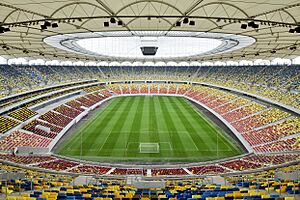
There are also sports clubs for handball, water polo, volleyball, rugby union, basketball, and ice hockey. Many Romanian athletes in track and field and gymnastics are part of clubs in Bucharest. The largest indoor arena is the Romexpo Dome, which can hold 40,000 people for events like boxing and tennis.
Bucharest used to host car races on a temporary track around the Palace of the Parliament. The city has also hosted international tennis tournaments. Ice hockey games are played at the Mihai Flamaropol Arena. Rugby games are held at the Arcul de Triumf Stadium.
Bucharest was one of the host cities for the UEFA Euro 2020 football championship, which took place in 2021.
Partner Cities
Bucharest is connected with many cities around the world. These are called twin towns or sister cities:
Bucharest also has a partnership with:
 Yerevan, Armenia (since 2013)
Yerevan, Armenia (since 2013)
Images for kids
See also
 In Spanish: Bucarest para niños
In Spanish: Bucarest para niños


